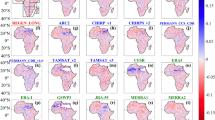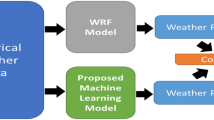Abstract
To meet the demand of the growing population, there exists pressure on food production. In this context, appropriate prediction of crop yield helps in agricultural production planning. Given the inability of the traditional linear models to provide satisfactory prediction performance, there is a need to develop a crop yield prediction model that is simple in complexity, accurate in prediction, and less time-consuming during training and validation phases. Keeping these objectives in view, the present paper focuses on building an adaptive, low complexity, and accurate nonlinear model for the prediction of crop yield. A time series dataset for the period 1991–2012 of Karnataka, a southwestern state of India, is used for yield prediction. An empirical nonlinear relation between crop yield and the four independent attributes has been obtained from the proposed ANN model. The independent attributes employed are total rainfall, the cumulative distribution of temperature, the proportion of irrigated land, and the average amount of fertilizer used. It is demonstrated that the developed model exhibits better prediction accuracy, less root mean square error in the range of 0.07–0.14, less mean square error in the range of 0.01–0.04, and mean absolute error in the range of 0.07–0.15 compared to its corresponding linear regression model. It is recommended that the proposed ANN model can also be applied to predict other agricultural products of the same or other geographical regions of the globe.





Similar content being viewed by others
Data availability
The data used in this study can be available upon request.
References
Abrougui, K., Gabsi, K., Mercatoris, B., Khemis, C., Amami, R., & Chehaibi, S. (2019). Prediction of organic potato yield using tillage systems and soil properties by artificial neural network (ANN) and multiple linear regressions (MLR). Soil and Tillage Research, 190, 202–208.
Adisa, O. M., Botai, J. O., Adeola, A. M., Hassen, A., Botai, C. M., Darkey, D., & Tesfamariam, E. (2019). Application of artificial neural network for predicting maize production in South Africa. Sustainability, 11(4), 1145.
Akbar, A., Kuanar, A., Patnaik, J., Mishra, A., & Nayak, S. (2018). Application of artificial neural network modeling for optimization and prediction of essential oil yield in turmeric (Curcuma longa L.). Computers and Electronics in Agriculture, 148, 160–178.
Alvarez, R. (2009). Predicting average regional yield and production of wheat in the Argentine Pampas by an artificial neural network approach. European Journal of Agronomy, 30(2), 70–77.
Amaratunga, V., Wickramasinghe, L., Perera, A., Jayasinghe, J., & Rathnayake, U. (2020). Artificial neural network to estimate the paddy yield prediction using climatic data. Mathematical Problems in Engineering, 2020, 1–11.
Arshad, M., Amjath-Babu, T. S., Krupnik, T. J., Aravindakshan, S., Abbas, A., Kachele, H., & Müller, K. (2017). Climate variability and yield risk in South Asia’s rice–wheat systems: Emerging evidence from Pakistan. Paddy and Water Environment, 15(2), 249–261.
Bhende, M. J. (2013). Agricultural profile of Karnataka state. Agricultural Development and Rural Transformation Centre Institute for Social and Economic Change, Bangalore.
Blagojević, M., Blagojević, M., & Ličina, V. (2016). Web-based intelligent system for predicting apricot yields using artificial neural networks. Scientia Horticulturae., 213, 125–131.
Carleton, T. A. (2017). Crop-damaging temperatures increase suicide rates in India. Proceedings of the National Academy of Sciences., 114(33), 8746–8751.
Crane-Droesch, A. (2018). Machine learning methods for crop yield prediction and climate change impact assessment in agriculture. Environmental Research Letters, 13(11), 114003.
Dang, C. Liu, Y. Yue, H. Qian, J. and Zhu, R. 2020. Autumn Crop Yield Prediction using Data-Driven Approaches:-Support Vector Machines, Random Forest, and Deep Neural Network Methods. Canadian Journal of Remote Sensing. 1–20.
Drummond, S. T., Sudduth, K. A., Joshi, A., Birrell, S. J., & Kitchen, N. R. (2003). Statistical and neural methods for site–specific yield prediction. Transactions of the ASAE, 46(1), 5.
Fisher, A. C., Hanemann, W. M., Roberts, M. J., & Schlenker, W. (2012). The economic impacts of climate change: Evidence from agricultural output and random fluctuations in weather: Comment. American Economic Review, 102(7), 3749–3760.
Fortin, J. G., Anctil, F., Parent, L., & Bolinder, M. A. (2011). Site specific early season potato yield forecast by neural network in Eastern Canada. Precision Agriculture, 12(6), 905–923.
Godfray, H. C. J., Beddington, J. R., Crute, I. R., Haddad, L., Lawrence, D., Muir, J. F., & Toulmin, C. (2010). Food security: The challenge of feeding 9 billion people. Science, 327(5967), 812–818.
Gonzalez-Sanchez, A., Frausto-Solis, J., & Ojeda-Bustamante, W. (2014). Attribute selection impact on linear and nonlinear regression models for crop yield prediction. The Scientific World Journal, 2014, 1–10.
Gopal, P. M., & Bhargavi, R. (2019). A novel approach for efficient crop yield prediction. Computers and Electronics in Agriculture., 165, 104968.
Gregory, P. J., & George, T. S. (2011). Feeding nine billion: The challenge to sustainable crop production. Journal of Experimental Botany, 62, 5233–5239.
Guhathakurta, P., Rajeevan, M., Sikka, D. R., & Tyagi, A. (2015). Observed changes in southwest monsoon rainfall over India during 1901–2011. International Journal of Climatology, 35(8), 1881–1898.
Gupta, R., Somanathan, E., & Dey, S. (2017). Global warming and local air pollution have reduced wheat yields in India. Climatic Change, 140(3), 593–604.
Irmak, A., Jones, J. W., Batchelor, W. D., Irmak, S., Boote, K. J., & Paz, J. O. (2006). Artificial neural network model as a data analysis tool in precision farming. T ASABE, 49(6), 2027–2037.
Jena, P. R., & Majhi, R. (2021). An application of artificial neural network classifier to analyze the behavioral traits of smallholder farmers in Kenya. Evolutionary Intelligence, 14(2), 281–291.
Ji, B., Sun, Y., Yang, S., & Wan, J. (2007). Artificial neural networks for rice yield prediction in mountainous regions. The Journal of Agricultural Science, 145(3), 249–261.
Kalli, R., & Jena, P. R. (2020). Impact of climate change on crop yields: Evidence from irrigated and dry land cultivation in semi-arid region of India. Journal of Environmental Accounting and Management., 8(1), 19–30.
Kalli, R., & Jena, P. R. (2021). Combining agriculture, social and climate indicators to classify vulnerable regions in the Indian semi-arid regions. Journal of Water and Climate Change, 13(2), 542–556.
Kalli, R., & Jena, P. R. (2022). How large is the farm income loss due to climate change? Evidence from India. China Agricultural Economic Review, 14(2), 331–348.
Khaki, S., & Wang, L. (2019). Crop yield prediction using deep neural networks. Frontiers in Plant Science, 10, 621.
Lobell, D. B., & Burke, M. B. (2010). On the use of statistical models to predict crop yield responses to climate change. Agricultural and Forest Meteorology, 150(11), 1443–1452.
Majhi, R., Panda, G., & Sahoo, G. (2009). Development and performance evaluation of FLANN based model for forecasting of stock markets. Expert Systems with Applications, 36(3), 6800–6808.
Mendelsohn, R. (2008). The impact of climate change on agriculture in developing countries. Journal of Natural Resources Policy Research, 1(1), 5–19.
Mendelsohn, R. (2014). The impact of climate change on agriculture in Asia. Journal of Integrative Agriculture, 13(4), 660–665.
Mendelsohn, R., Nordhaus, W. D., & Shaw, D. (1994). The Impact of global warming on agriculture: A Ricardian analysis. The American Economic Review, 84(4), 753–771.
Pai, D. S., Sridhar, L., Badwaik, M. R., & Rajeevan, M. (2015). Analysis of the daily rainfall events over India using a new long period (1901–2010) high resolution (0.25× 0.25) gridded rainfall data set. Climate Dynamics, 45(3–4), 755–776.
Pao, Y. 1989. Adaptive pattern recognition and neural networks.
Patra, J. C., Pal, R. N., Chatterji, B. N., & Panda, G. (1999). Identification of nonlinear dynamic systems using functional link artificial neural networks. IEEE Transactions on Systems, Man and Cybernetics, Part B (Cybernetics), 29(2), 254–262.
Roel, A., & Plant, R. E. (2004). Factors underlying yield variability in two California rice fields. Agronomy Journal, 96, 1481–1494.
Safa, M., & Samarasinghe, S. (2011). Determination and modelling of energy consumption in wheat production using neural networks: “A case study in Canterbury province, New Zealand.” Energy, 36(8), 5140–5147.
Sanghi, A., & Mendelsohn, R. (2008). The impacts of global warming on farmers in Brazil and India. Global Environmental Change, 18(4), 655–665.
Saxena, R., Vanga, S. K., Wang, J., Orsat, V., & Raghavan, V. (2018). Millets for food security in the context of climate change: A review. Sustainability, 10(7), 2228.
Schlenker, W., & Roberts, M. J. (2006). Nonlinear effects of weather on corn yields. Review of Agricultural Economics, 28(3), 391–398.
Schlenker, W., & Roberts, M. J. (2009). Nonlinear temperature effects indicate severe damages to U.S. crop yields under climate change. Proceedings of the National Academy of Sciences, 106(37), 15594–15598.
Schlenker, W., Hanemann, W. M., & Fisher, A. C. (2005). Will U.S. agriculture really benefit from global warming? Accounting for irrigation in the hedonic approach. American Economic Review, 95(1), 395–406.
Schlenker, W., Hanemann, W. M., & Fisher, A. C. (2006). The impact of global warming on US agriculture: An econometric analysis of optimal growing conditions. Review of Economics and Statistics, 88(1), 113–125.
Shook, J., Gangopadhyay, T., Wu, L., Ganapathysubramanian, B., Sarkar, S., & Singh, A. K. (2021). Crop yield prediction integrating genotype and weather variables using deep learning. PLoS ONE, 16(6), e0252402.
Srivastava, A. K., Rajeevan, M., & Kshirsagar, S. R. (2009). Development of a high resolution daily gridded temperature data set (1969–2005) for the Indian region. Atmospheric Science Letters., 10(4), 249–254.
Sultan, B., Guan, K., Kouressy, M., Biasutti, M., Piani, C. H., & GL. and Lobell, DB. (2014). Robust features of future climate change impacts on sorghum yields in West Africa. Environmental Research Letters, 9(10), 104006.
Taheri-Rad, A., Khojastehpour, M., Rohani, A., Khoramdel, S., & Nikkhah, A. (2017). Energy flow modeling and predicting the yield of Iranian paddy cultivars using artificial neural networks. Energy, 135, 405–412.
Tantalaki, N., Souravlas, S., & Roumeliotis, M. (2019). Data-driven decision making in precision agriculture: The rise of big data in agricultural systems. Journal of Agricultural & Food Information, 20(4), 344–380.
Traore, S., Zhang, L., Guven, A., & Fipps, G. (2020). Rice yield response forecasting tool (YIELDCAST) for supporting climate change adaptation decision in Sahel. Agricultural Water Management, 239, 106242.
Tian, X., Engel, B. A., Qian, H., Hua, E., Sun, S., & Wang, Y. (2021). Will reaching the maximum achievable yield potential meet future global food demand? Journal of Cleaner Production, 294, 126285.
Wang, P., Zhang, Z., Song, X., Chen, Y., Wei, X., Shi, P., & Tao, F. (2014). Temperature variations and rice yields in China: Historical contributions and future trends. Climatic Change, 124(4), 777–789.
Widrow, B., & Stearns, S. (2002). Adaptive signal processing (p. 2002). Pearson Education.
Funding
This study is funded by Scheme for Promotion of Academic Research and Collaboration (SPARC) project, Ministry of Education, Government of India (Grant No. P-302).
Author information
Authors and Affiliations
Corresponding author
Ethics declarations
Conflict of interest
The authors have no conflict of interest.
Ethical approval
Not Applicable.
Additional information
Publisher's Note
Springer Nature remains neutral with regard to jurisdictional claims in published maps and institutional affiliations.
Rights and permissions
About this article
Cite this article
Jena, P.R., Majhi, B., Kalli, R. et al. Prediction of crop yield using climate variables in the south-western province of India: a functional artificial neural network modeling (FLANN) approach. Environ Dev Sustain 25, 11033–11056 (2023). https://doi.org/10.1007/s10668-022-02517-x
Received:
Accepted:
Published:
Issue Date:
DOI: https://doi.org/10.1007/s10668-022-02517-x




